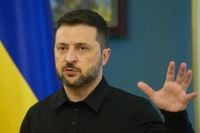Europe’s largest nuclear facility, the Zaporizhzhia Nuclear Power Plant (ZNPP), finds itself at the epicenter of mounting international concern after suffering a record-breaking blackout. As of late September 2025, the plant has been running on emergency diesel generators for over five days, following the severing of its last external power line—a development Greenpeace Ukraine and Ukrainian officials attribute to deliberate Russian sabotage.
The blackout began on September 23, 2025, when the final power line connecting ZNPP to Ukraine’s energy grid was lost. According to a study published by Greenpeace Ukraine on September 27, the damage occurred between two and five kilometers north of the plant’s switchyard, along a 750-kilovolt line running toward the Dnipro River. Crucially, the study—based on satellite imagery—found no evidence of shelling or attacks prior to the loss of connection, leading Greenpeace to assert, “This is indicative of deliberate sabotage by Russian forces.”
The implications are dire. The plant’s six reactors, though in a so-called cold shutdown, still require constant cooling to prevent overheating and a potential meltdown. Emergency diesel generators have become the last line of defense, powering cooling and safety systems. “Emergency diesel generators are considered the last line of defence, used only in extreme circumstances,” Jan Vande Putte, a radiation and nuclear energy specialist at Greenpeace Ukraine, told the press. He further warned, “These are undoubtedly the most serious and important events since the beginning of the occupation of the ZNPP by Russia in March 2022.”
Ukrainian officials echoed these concerns. Svitlana Hrynchuk, Ukraine’s Minister of Energy, told The Associated Press, “The plant remains in blackout mode, which is a significant violation of the conditions for its normal operation.” She noted this marks the tenth such incident since Russia’s full-scale invasion in February 2022. Hrynchuk attributed the blackout to “another shelling by the Russians, which damaged the only power transmission line supplying the plant from the Ukrainian energy system.”
The situation has drawn the attention of the International Atomic Energy Agency (IAEA). Its director general, Rafael Grossi, met with Russian President Vladimir Putin on September 25, 2025, but the meeting failed to restore external power to the facility. The IAEA continues to rotate staff through the plant to monitor its safety and provide expertise, but the risk remains high. The agency has repeatedly warned of the possibility of a radiation disaster akin to Chernobyl or Fukushima if power is not restored and cooling systems fail.
Greenpeace Ukraine’s latest satellite analysis suggests that Russian authorities may be exploiting the crisis for strategic gains. The environmental group claims that Russian engineers are constructing a 201-kilometer (125-mile) power line between occupied Melitopol and Mariupol, with work having started in December 2024. The goal, according to Greenpeace, is to disconnect ZNPP from Ukraine’s grid and reconnect it to the Russian-controlled power network in the occupied south and east. “Russia and Rosatom may take advantage of the current crisis, which they deliberately created, to try to reconnect to Ukraine’s power grid, temporarily occupied by Russia, south and east of the ZNPP. The next step could be attempts to start at least one nuclear reactor,” Greenpeace warned in its statement.
Further complicating matters, Greenpeace reports that Russia has completed a new water supply system for the plant’s cooling pond—another sign that preparations may be underway to restart at least one reactor despite the ongoing war. The Associated Press noted it could not independently verify all elements of Greenpeace’s analysis, but the pattern of events has heightened suspicions among Ukrainian and international observers.
The risks are not merely theoretical. With the plant relying on diesel generators for more than 72 hours, the specter of uncontrolled reactor heating—comparable to the Fukushima scenario—has become a real concern. Satellite images and on-the-ground reports indicate that the generators are operating at maximum capacity, raising questions about how long they can sustain safe conditions at the facility. The Russian-controlled Telegram channel for the plant attempted to reassure, stating, “Sufficient diesel fuel reserves are available on-site to ensure long-term autonomous operation of the generators.” Still, experts warn that even the best-prepared stockpiles have limits, especially in a war zone where supply lines are vulnerable.
Ukrainian Foreign Minister Andrii Sybiha accused the Russian occupiers of attempting to involve the IAEA in reconnecting the station “to justify the theft.” The underlying fear is that Moscow will use the blackout as a pretext to permanently sever the plant from Ukraine’s grid, consolidating its hold over the region’s critical infrastructure.
The high-stakes drama at ZNPP is unfolding against a backdrop of escalating military and diplomatic tensions. On September 27, 2025, Ukrainian President Volodymyr Zelensky announced a $90 billion arms deal with the United States, which he described as a “mega deal” for weapons purchases, including a separate agreement for Ukrainian-made drones. “We discussed and agreed on the main points with the President [Trump]. Now we are moving on to practical implementation,” Zelensky said, emphasizing Ukraine’s urgent need for long-range weapons systems.
Meanwhile, Zelensky criticized Hungary for what he called “dangerous” drone intelligence activities over Ukrainian territory, stating that Ukrainian intelligence had tracked at least one Hungarian drone. “I believe they are doing very dangerous things – very dangerous things, first and foremost for themselves,” Zelensky said. Hungarian Foreign Minister Peter Szijjarto dismissed the allegations, responding on Facebook that the Ukrainian president “lost his mind” and was “seeing things.” Hungary, under Prime Minister Viktor Orbán, has maintained close ties with Russia and has often criticized Western military aid to Ukraine.
Adding another layer to Ukraine’s defense posture, Zelensky disclosed that an Israeli Patriot air defense system has been operating in Ukraine for the past month, with two additional Patriot systems expected to arrive in the fall. Israel’s defense ministry declined to comment on the deployment, but the move marks a notable step in Ukraine’s efforts to bolster its air defenses amid persistent threats from Russian missile and drone attacks.
As the situation at Zaporizhzhia remains precarious, the world watches anxiously. The risk of a nuclear disaster looms over not just Ukraine, but all of Europe, as the struggle for control over the plant and its power lines becomes yet another front in the ongoing conflict. For now, the emergency generators keep disaster at bay—but for how long remains an open and deeply unsettling question.




